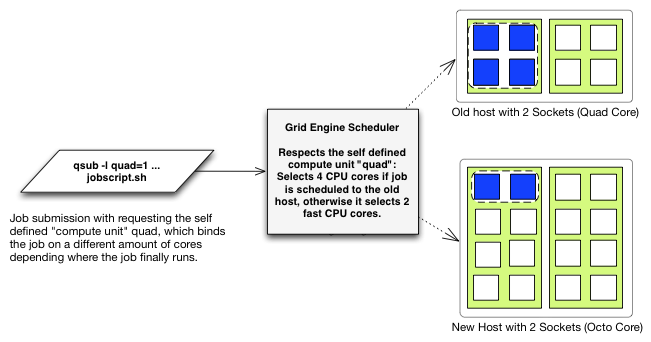Fun With Grid Engine Topology Masks -or- How to Bind Compute Jobs to Different Amount of Cores Depending where the Jobs Run (2013-01-09)
A compute cluster or grid often varies in the hardware installed. Some compute
nodes offers processors with strong compute capabilities while others are
older and slower. This becomes an issue when parallel compute jobs are
submitted to a job/cluster scheduler. When the jobs runs on slower
hardware it should use more compute cores than on faster cores. But during
submission time the parameters (like the amount of cores used for core
binding) are often fixed. An obvious solution is to restrict the scheduler
that the job can only run on a specific cluster partition with similar
hardware (like in Grid Engine a queue domain requested with -q
queue@@hostgroup). But the drawback of this approach is that the
cluster is not fully utilized while jobs are waiting for getting a fast
machine.
An alternative would be to exploit the new Grid Engine topology masks
introduced in Univa Grid Engine 8.1.3. While with the core binding
submission parameter (qsub -binding) a job requests a specific fixed
amount of cores for the job, the topology mask bind the core
selection request to the resource (i.e. execution machine the scheduler selects). Hence the Grid Engine scheduler can translate a virtual entity into the machine
specific meanings. That‘s a bit abstract, hence an example should
demonstrate it:
We assume that we have two types of machines in our cluster, old two
socket quad-core processors and new octo-core machines also with two
sockets. The workload creates lots of threads or can create as much
threads as processors are available (during job execution the processors
can be get from the $SGE_BINDING environment variable). What we can do now
is defining a virtual compute entity, which expresses some compute power.
Let‘s call it quads here. Since the old compute cores are slower than the
new one you can define that a quad for the old machines are all four cores
of processor, while on the new host a quad is equivalent to two cores (or
one core if you like).
All what you have to do is to define the new compute entity quad in the Grid
Engine complex configuration as a per host consumable with type
RSMAP (resource map).
qconf -mc
quad qd RSMAP <= YES HOST 0 0
Now we need to assign the quads to the hosts. This is done in the host configuration. At an old host a quad represents 4 cores. Hence 2 quads are available per host.
qconf -me oldhost
complex_values quad=2(quad1:SCCCCScccc quad2:SccccSCCCC)
Now we have two quad resources available: quad1 which is bound to the 4
cores on the first socket and quad2 which is available on the 4 cores of
the second socket.
The same needs to be done on the new hosts, but now a quad are just two CPU
cores.
qconf -me newhost
complex_values quad=8(quad1:SCCccccccScccccccc quad2:SccCCccccScccccccc \
quad3:SccccCCccScccccccc quad4:SccccccCCScccccccc \
quad5:SccccccccSCCcccccc quad6:SccccccccSccCCcccc \
quad7:SccccccccSccccCCcc quad8:SccccccccSccccccCC)
This looks like a little work for the administrator but afterwards it is
very simple to use. The user just has to request the amount of quads he
wants for the job and finally the core selection and core binding for the job is automatically done. The scheduler selects always the first free quad in the order of the complex values definition. Following job
submission demonstrates it:
qsub -l quad=1 -pe mytestpe 4 -b y sleep 123

In order to force all jobs to use this compute entity quad, a JSV
script could be written which adds the request to all jobs
(while it disallows any existing core binding requests).
When now the job runs on a new host it is bound on two cores, while when
the job is scheduled by Grid Engine to an on old host it runs on four
cores. Of course you can also request as many quads as you like. NB: When
requesting more then 2 quads per job, the job can‘t be scheduled to an old
host. It will run only on new hosts. The quads are a per host requests,
meaning that on each host the job runs that amount of quads you had
requested are chosen (independent from the requested and granted amount of
slots on this host).
This feature is unique in Univa
Grid Engine and was introduced in UGE 8.1.3.
